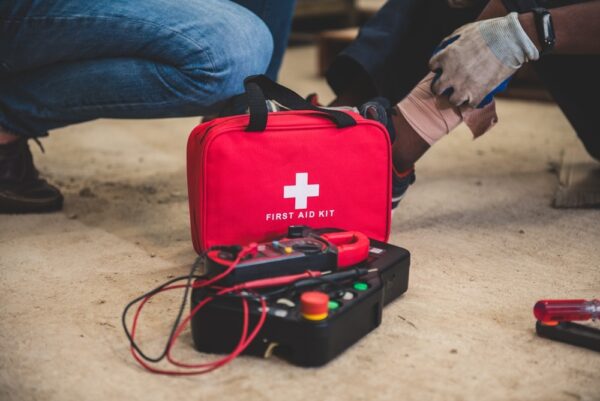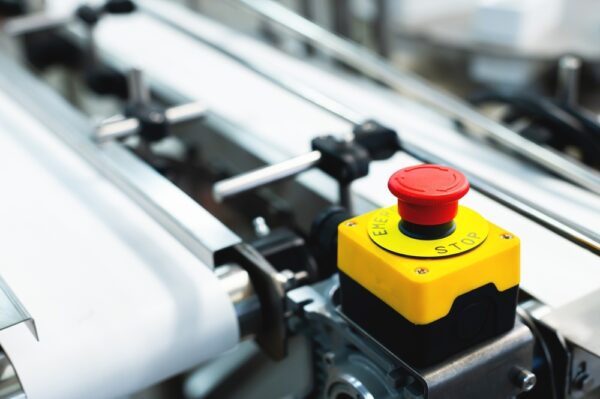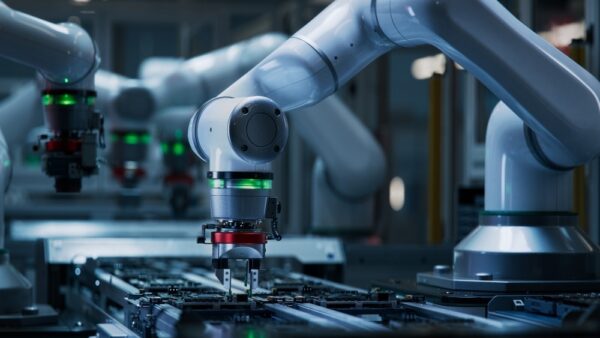
The integration of robotics and manufacturing brings exciting advancements in efficiency and productivity. However, it’s crucial to prioritize robot safety to safeguard workers and ensure smooth operations.
We want to empower our customers with the knowledge to keep their production efficient, uninterrupted, and safe. And the best way to reduce industrial machine risks is to proactively identify and eliminate hazards.
With the right safety plans, innovative safety technology, and a commitment to maintenance and training, your manufacturing floor can safely accommodate machines and robotics of any size, speed, and power.
In this guide, we’ll look into the essential elements of robotics safety, covering robot safety standards, potential hazards in the workplace, and strategies for ensuring a safe robot environment.
Related Reading: Comprehensive Guide to Industrial Automation
Key Hazards in Industrial Robotics
As robots in the workplace become increasingly common, understanding the key hazards they pose is crucial for ensuring robot safety. When machines operate at high speeds near workers, it’s essential to be aware of the different risks they present. Knowing these definitions is a fundamental step in your robot safety risk assessment practices.
Struck-by Hazards in Industrial Robotics
Struck-by hazards are a serious concern in environments with industrial robots. These hazards involve being forcefully impacted by a moving robot, its components, or objects within the robot’s workspace. Flying, falling, swinging, or rolling objects propelled by the robot can cause significant injuries. It’s important to distinguish struck-by hazards from caught, crushing, or trapping hazards, which involve different mechanisms of injury, to ensure proper risk reduction.
Here are some solutions to avoid struck-by hazards:
- Barriers and Guards: Install physical barriers to prevent workers from entering the robot’s workspace during operation.
- Presence-Sensing Devices: Utilize sensors that automatically stop the robot when someone enters the hazard zone.
- Safe Distances: Maintain safe distances between workers and operating robots.
- Training: Thoroughly train workers to identify struck-by hazards and how to avoid them.
Caught, Crushing and Trapping Hazards

Caught, crushing, and trapping hazards pose a significant risk within robotic workspaces. These injuries occur when a worker is compressed between two objects, often involving a robot component. While impact injuries can also be a factor, the primary danger lies in the compression itself. Implementing robust safety circuit integration is crucial to avoid the risks associated with sudden malfunctions in robots.
Technologies like our NodeUDesign Nodes, designed for speed and precision for our automation and OEM equipment, often incorporate advanced safety features to further reduce these risks.
- Safe Circuit Integration: Design and implement secure safety circuits to prevent malfunctions or unexpected movements.
- Emergency Stops: Ensure emergency stops are easily accessible and regularly tested.
- Lockout/Tagout: Employ lockout/tagout procedures during maintenance to completely cut off power to the robot.
- Awareness: Train workers to be aware of pinch points and potential crushing hazards.
Hydraulic Hazards and Robotic Systems
Robots using hydraulic systems introduce specific safety concerns. Exposure to hydraulic fluid due to leaks poses serious risks, including toxicity if ingested, irritation to the eyes, and potential harm if inhaled.
The extremely high pressure found in hydraulic systems (up to 10,000 psi) can lead to struck-by and crushing hazards if sudden pressure loss occurs. High-pressure leaks can even penetrate safety guards, causing injuries. It’s also important to be aware that hydraulic fluids can be flammable and typically operate between 120 and 180 degrees, posing a potential fire and burn hazard. To avoid hydraulic hazards, your automation integrator will suggest the following:
- Leak Prevention: Regularly inspect and maintain hydraulic systems to prevent leaks.
- Protective Gear: Provide workers with appropriate PPE (gloves, eye protection, etc.) when handling hydraulic fluids.
- Fire Safety: Apply fire prevention measures in areas with hydraulic systems.
Related Reading: Choosing the Right Automation Partner
Electrical Safety in Robotics
Electrical hazards pose significant risks in environments with industrial robots. Unsafe contact with power supplies, cords, exposed wiring, or defective components can lead to dangerous arc flashes, shocks, fires, and burns. Improper grounding and wet conditions only increase these risks. Consider safeguarding high-power and low-power controls separately to enhance electrical safety, potentially using separate cabinets.
- Proper Grounding: Ensure electrical systems are properly grounded to prevent shocks.
- Lockout/Tagout: Use lockout/tagout procedures when working on electrical components.
- Protective Gear: Equip workers with insulating gloves and footwear when necessary.
- Maintenance: Regularly inspect and maintain electrical systems to identify and address potential hazards. Timely maintenance and upgrades for automation systems are critical to ensure worker safety.
Pneumatic Hazards in Robotic Work Cells
Pneumatic systems introduce a unique set of safety risks. The powerful air pressure used can launch objects at dangerous speeds. Burst fasteners, tubing, or unfastened pressurized air lines pose serious hazards, potentially striking workers with unexpected force. To reduce these risks, adopting robust safety protocols and ensuring all pneumatic components are securely fastened is essential.
- Pressure Regulators: Utilize pressure regulators to control air pressure within safe limits.
- Secure Fastenings: Ensure all pneumatic fasteners and tubing are securely fastened.
- Training: Educate workers on the dangers of pressurized air and proper safety procedures.
Preventing Slips, Trips, and Falls in Robotic Workspaces

Slips, trips, and falls are easily overlooked but pose serious hazards in robotic environments. These incidents can cause minor injuries or have life-altering consequences. Common causes include:
- Unsecured cables and hoses snaking across walkways
- Debris or spills that create slippery surfaces
- Inadequate lighting that obscures potential hazards.
By proactively addressing these issues, you can significantly reduce the risk of worker injuries and ensure a safer work environment for everyone.
- Housekeeping: Maintain clean and organized workspaces to prevent slips, trips, and falls.
- Lighting: Ensure adequate lighting throughout the work area.
- Cables and Hoses: Securely cover or route cables and hoses to prevent tripping hazards.
- PPE: Provide non-slip footwear if necessary.
Environmental Hazards in Robotic Workspaces
Environmental hazards cover a wide range of risks. Workers could potentially be exposed to harmful chemicals, fumes, extreme temperatures, dust, radiation, explosive materials, biohazards, excessive noise, sparks, or bright light, depending on your robot’s placement and the products it handles.
Even factors like workplace violence or stress can be considered environmental hazards. It’s crucial to assess and reduce these risks to ensure worker safety.
- Ventilation: Implement proper ventilation systems to control fumes, dust, and other airborne hazards.
- Hazard Labeling: Clearly label hazardous substances and areas.
- PPE: Provide appropriate PPE (respirators, protective clothing, ear protection, etc.) based on the specific hazards present.
- Risk Assessment: Conduct thorough risk assessments to identify all potential environmental hazards and adopt the appropriate strategies.
Related Reading: Understanding Turnkey Automation in Manufacturing
Innovative Robotic Safety Solutions

Modern robotic safety strategies center around three key areas: advanced safety equipment, strategic robot placement, and comprehensive operator training. By effectively implementing these elements, you can significantly reduce the risks associated with the hazards we’ve discussed.
Advanced Safety Equipment for Robotic Workspaces
Robotic workplaces demand a comprehensive safety strategy utilizing advanced safety equipment to create a safe and productive environment for human-robot collaboration. This equipment encompasses a variety of technologies that work together to safeguard workers and minimize risks.
Barrier Guards
Barrier guards provide a physical layer of protection in robotic workspaces. They come in various forms to address different hazard types:
- Fixed Guards: Permanent barriers ideal for preventing struck-by, caught, crushing, and trapping hazards.
- Interlocked Guards: Halt operation upon opening, offering protection with easier maintenance access.
- Awareness Barriers: Define the safety perimeters that are best used alongside other guard types or in low-risk zones.
Presence-Sensing Devices
Presence-sensing devices utilize various technologies to create invisible safety zones around robots. These zones can be tailored to each robot’s specific reach and movement patterns, ensuring workers remain at a safe distance during operation.
These advanced sensors can create more complex safety fields, which are ideal for robots with intricate movements or those operating in collaborative workspaces alongside human workers. Examples include:
- Light Curtains: These opto-electronic devices create a vertical or horizontal screen of light using a series of transmitters and receivers. Any physical interruption of the curtain (e.g., a worker walking through the light curtain) triggers an interlock-style shutdown of your machine.
- Pressure Sensitive Safety Mats: These industrial-grade floor mats use integrated pressure-sensitive plates capable of detecting the weight of a human or object. They come in assorted styles, sizes, and colors customized to the work envelope.
- Wearables: Sometimes integrated into PPE or uniforms, these small detection devices track and alert workers to unsafe distances from a machine, temperatures, or chemicals using visual or audible alerts. They can also connect with interoperable sensors to shut down mobile robots before imminent contact.
Emergency Stops: The Critical Safety Fail-Safe in Robotics
Emergency stops are indispensable safety devices in any robotic workspace. These buttons, levers, or pull cords provide a critical fail-safe, allowing workers to immediately halt robot motion in the event of a hazard. Strategically located within easy reach of all operators and workers, they actively counteract a robot’s movement and remain engaged even after power disruptions, preventing unexpected restarts.
Control Devices
Located outside hazardous work zones and within clear sight of the robot, control devices or Human-Machine Interfaces (HMIs) are the nerve centers for safe robot operation. They include panels, screens, or pendants equipped with clear labeling, instructions, emergency stops, and status indicators.
HMIs prioritize intuitive design and safeguards to prevent accidental button or switch activation. Importantly, while emergency brakes halt robot motion, control devices are essential for restarting a robot after any shutdown.
Important Note: Always choose safety equipment based on a thorough risk assessment of your specific robotic application. Implementing a combination of these technologies is often the most effective approach.
Audio-Visual Warnings in Robotic Workspaces
Audio and visual warnings are crucial components of a comprehensive robotics safety strategy. They help ensure safe conduct, clearly define zones, and immediately signal emergencies:
- Lights, Emergency Tape, and Signage: These visual cues inform workers and operators about potential hazards, safety protocols, and designated work areas around robots.
- Displays, Gauges, and Monitors: Provide real-time information on machine or robot status to promote safe interaction and troubleshooting and maintain robotics and manufacturing efficiency.
- Audible Alerts: Distinct alarms for emergencies ensure rapid response, safeguarding workers in dangerous situations.
To maximize the effectiveness of audio-visual warnings in robotic environments, consider these key factors:
- Visibility: Ensure high-contrast markings and bright lights in a manufacturing environment.
- Standardization: Follow industry robot safety standards for colors, symbols, and alert types to prevent misinterpretation.
- Integration: Audio-visual warnings often work in conjunction with other safety equipment (presence-sensing devices, barrier guards) to provide layered protection in the workplace.
Related Reading: The Future of Robotics in Manufacturing
Placement Safety: Key Considerations for Robotics in the Workplace

Strategic placement, orientation, and secure installation are crucial for maximizing robot safety and protecting workers and equipment. Here’s why placement matters:
- Securing: Robots operating at high speeds or maximum force can generate vibration, potentially leading to instability or movement. So, proper securing techniques are essential to prevent tipping and other hazards and ensure safe robot operation.
- Environment: Harsh manufacturing environments can pose risks to robotic systems. Consider factors like temperature, chemicals, dust, and potential electrical hazards. Choose robots with the appropriate Ingress Protection Rating (IP rating) for safe and reliable operation within your facility’s specific conditions.
Here are some additional tips for optimal robot placement:
- Accessibility: Plan for maintenance accessibility while still considering worker protection.
- Workspace: Ensure the robot’s reach and workspace are compatible with the task and layout.
- Future Expansion: If applicable, allow for potential modifications or additions to your robotic system.
Best Practices for Robotics Safety and Ownership
While robot safety technology continues to evolve, a proactive safety culture is still paramount for ensuring robots in the workplace operate safely. Here are key strategies to promote a strong safety mindset:
- Operation Training: Comprehensive training on the use, programming, and basic maintenance of your robot is essential for all supervisors, managers, and operators to encourage the safety and efficient operation of robotics.
- Safety Policy: Implement a clear written safety policy outlining hazard prevention, authorized personnel, and safe robot operation procedures. This policy helps maintain a safe and informed work environment within robotics and manufacturing spaces.
- Safety Checklists: Utilize both pre-operation checklists (visual inspections, status checks) and periodic condition checklists to ensure your robot remains in good working order, minimizing safety risks.
- Regular Maintenance: Prioritize regular maintenance schedules for your robotic systems. A well-maintained robot is less likely to malfunction, protecting both production quality and worker safety. This focus on maintenance contributes to overall robot safety standards.
Related Reading: Choosing Your First Automation Project
Qualities of Effective Automation Safety
Successfully implemented robotic safety focuses on three core areas. Consider these when creating your safety plan to avoid complacency:
- Simplicity: Robotics safety solutions should streamline and minimize the steps needed to address hazards. Procedures must be clear and well-defined, promoting safe robot operation.
- Cost-Effectiveness: While some downtime for maintenance is inevitable, plan for scheduled repairs and parts replacements to reduce unexpected disruptions. This proactive approach contributes to overall robot safety and production efficiency.
- Intuitiveness: Although specialized training is always essential, basic safety principles around the robot should be easy to understand. Utilize context clues, clear warnings, descriptive labeling, and preventative barriers. Make safety training materials readily accessible to all staff, creating a culture of safety awareness in robotics and manufacturing environments.
Related Reading: The Top 8 Myths of Automation
The Path to Safe and Efficient Robotics Integration
Robotics and automation hold immense potential for transforming manufacturing. Yet, ensuring a safe work environment alongside these powerful machines is paramount. By prioritizing strategic placement, comprehensive safety methodologies, and a commitment to simplicity, cost-effectiveness, and intuitive design, you can harness the benefits of robotics while protecting your most valuable asset — your workforce.
Ready to unlock the full potential of robots in your workplace? DEVELOP LLC understands the complexities of robotic safety compliance. We specialize in customized safety solutions that meet your needs and align with industry standards for robot safety.
Imagine a workplace where robots boost productivity without compromising worker safety. Let’s make it happen! Here’s how to get started:
Or simply call (262)-622-6104.
Embrace the future of manufacturing with confidence. Let’s ensure your robotic integration prioritizes both safety and efficiency.
About the Author:
Sean McKittrick, as Project Program Coordinator at DEVELOP LLC, brings a multifaceted background from Knox College. McKittrick’s first year at DEVELOP LLC has been marked by significant team growth and zero turnover, showcasing his ability to build a collaborative and effective work environment. His experience spans quality management in healthcare software to managing production for a million pounds of material monthly, highlighting his diverse expertise in project coordination and manufacturing excellence.
